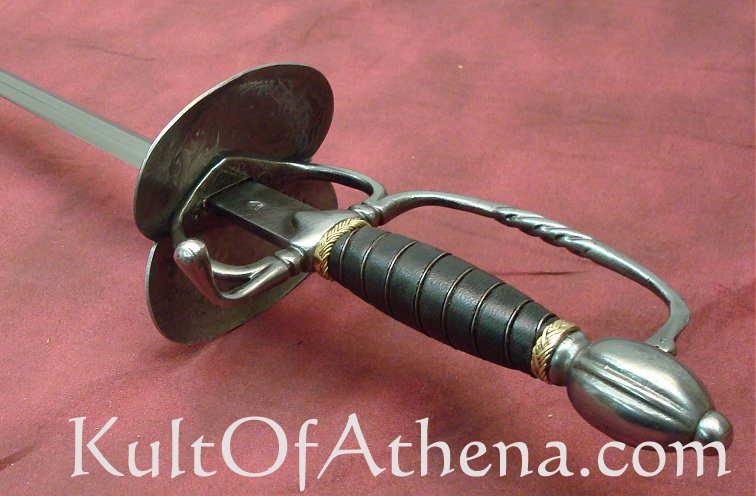Posts: 515
Thu 20 Aug, 2009 10:20 am
Del Tin 18th century Rapier.....
Posts: 845
Thu 20 Aug, 2009 11:30 am
It seems like more of a small sword than a rapier. Could you post the stats please? I can't access the KoA webpage from my work computer. :)
Posts: 4,393 Location: Northern California
Thu 20 Aug, 2009 12:20 pm
| JE Sarge wrote: |
| It seems like more of a small sword than a rapier. Could you post the stats please? I can't access the KoA webpage from my work computer. :) |
DT5182
Overall Length: 44 3/4'' Blade: 37''
Weight: 1 lb 11.9 oz
Edge: Unsharpened
P.O.B.: 3 5/16''
Thickness: 4.5 mm - 2.5 mm
Width: 21mm
Grip Length: 3 1/4''
Pommel: Peened
The hilt is longer than the typical smallsword, especially the finger rings. It looks like you can actually get your finger completely inside them, which you often can't do with a smallsword. The blade is also longer with a fuller.
I'm inexplicably drawn to this sword - I bet it's fast
 Attachment: 4.11 KB
Attachment: 4.11 KB

DT5181 smallsword
 Attachment: 4.15 KB
Attachment: 4.15 KB

DT5182 rapier
Posts: 4,194 Location: Northern VA,USA
Thu 20 Aug, 2009 12:51 pm
| JE Sarge wrote: |
| It seems like more of a small sword than a rapier. |
Its one of those cases where terminology is very vague. The word "rapier" was often used in the 18th century to describe smallswords.
Many modern scholars use the word "smallsword" to describe the smaller 18th c. swords, and "rapier" to describe the larger ones. In places such as Italy, larger ones seemed to be more common, and likely used techniques that were somewhere between 17th century rapier and 19th century classical fencing techniques.
Posts: 515
Thu 20 Aug, 2009 1:09 pm
I've found with smallswords from the first half of the 18th cen, that I can put my finger thru the pas de ans on them. However this sword is definately in the style of a 'transitional rapier" from the late 17th cen, which happens to be my favorite type of sword
Posts: 845
Thu 20 Aug, 2009 2:02 pm
It's definately interesting; thanks for the info/clarification, you learn something new every day. :D
Would you plan on removing the brass safety tip or leaving it for practical fencing use?
Posts: 515
Thu 20 Aug, 2009 3:59 pm
Good question. I might take off the brass tip to put a bird blunt on it for fencing. On the other hand, I wonder about a pienned pommel. I think it would start to come loose after some intense bouting. For practice weapons I like something that can be easily adjusted and or taken apart.
Posts: 214 Location: Sacramento, CA
Thu 20 Aug, 2009 5:14 pm
I handled one, and liked it enough to want it pretty bad :cool:
Posts: 4,194 Location: Northern VA,USA
Thu 20 Aug, 2009 7:46 pm
| Morgan Butler wrote: |
| Good question. I might take off the brass tip to put a bird blunt on it for fencing. On the other hand, I wonder about a pienned pommel. I think it would start to come loose after some intense bouting. For practice weapons I like something that can be easily adjusted and or taken apart. |
I can't vouch for this particular model, but I used to own the DT5181:
http://www.myArmoury.com/review_dt5181.html
[ Linked Image ]
This was used for quite a lot of smallsword fencing by me for awhile, and eventually was sold to a student who still uses it. While I agree, it'd be nice to be able to replace the blade for whenever the day comes that it needs it, so far its held up surprisingly well, with no signs of loosening. On the flip side, I've also had Del Tins that have come loose after very little training, but that was from several years ago, and I don't know if things have changed or not.
You
cannot post new topics in this forum
You
cannot reply to topics in this forum
You
cannot edit your posts in this forum
You
cannot delete your posts in this forum
You
cannot vote in polls in this forum
You
cannot attach files in this forum
You
can download files in this forum


